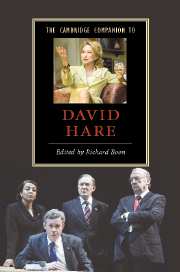Book contents
- Frontmatter
- Introduction
- Part I Text and context
- 1 Portable Theatre: ‘fine detail, rough theatre’
- 2 Keeping turning up
- 3 In opposition
- 4 Hare’s trilogy at the National
- 5 Hare’s ‘stage poetry’, 1995-2002
- 6 ‘Stopping for lunch’
- Part II Working with Hare
- Part III Hare on screen
- Part IV Overviews of Hare
- Selected Bibliography
- Index
3 - In opposition
Hare’s response to Thatcherism
from Part I - Text and context
Published online by Cambridge University Press: 28 April 2008
- Frontmatter
- Introduction
- Part I Text and context
- 1 Portable Theatre: ‘fine detail, rough theatre’
- 2 Keeping turning up
- 3 In opposition
- 4 Hare’s trilogy at the National
- 5 Hare’s ‘stage poetry’, 1995-2002
- 6 ‘Stopping for lunch’
- Part II Working with Hare
- Part III Hare on screen
- Part IV Overviews of Hare
- Selected Bibliography
- Index
Summary
The crisis in British theatre in the 1980s, precipitated by a withdrawal of state funding for and a lack of investment in the arts, a failure of the political Left, and a loss of confidence in theatre as a political arena, resulted not in conspicuous critical resistance to Prime Minister Margaret Thatcher's market economy by British playwrights but a nervous retreat from mainstream politics and the 'State of the Nation' play. The tradition of epic dramas which dissected the condition of Britain, so prevalent in the 1970s, was subdued in a theatre either too timid or too financially insecure to challenge the prevailing climate. At the same time, the political shift to the Right and the enterprise economy produced a theatre audience less interested in 'committed dramas' than in theatrical spectacle. As Michael Billington commented, 'What I missed in 1986 were plays that addressed themselves to the particular spirit of our times: most especially, the privatising greed . . . It is almost as if the present is too vile or daunting to be properly encompassed.'
- Type
- Chapter
- Information
- The Cambridge Companion to David Hare , pp. 49 - 63Publisher: Cambridge University PressPrint publication year: 2007
- 1
- Cited by

